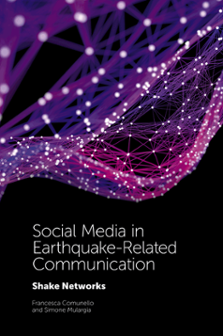
Prelims
Social Media in Earthquake-Related Communication
ISBN: 978-1-78714-792-8, eISBN: 978-1-78714-791-1
Publication date: 31 July 2018
Citation
Comunello, F. and Mulargia, S. (2018), "Prelims", Social Media in Earthquake-Related Communication, Emerald Publishing Limited, Leeds, pp. i-ix. https://doi.org/10.1108/978-1-78714-791-120181009
Publisher
:Emerald Publishing Limited
Copyright © 2018 Emerald Publishing Limited
Half Title Page
SOCIAL MEDIA IN EARTHQUAKE-RELATED COMMUNICATION: SHAKE NETWORKS
Title Page
SOCIAL MEDIA IN EARTHQUAKE-RELATED COMMUNICATION: SHAKE NETWORKS
BY
FRANCESCA COMUNELLO
LUMSA University, Rome, Italy
SIMONE MULARGIA
Sapienza University of Rome, Rome, Italy

United Kingdom – North America – Japan – India – Malaysia – China
Copyright Page
Emerald Publishing Limited
Howard House, Wagon Lane, Bingley BD16 1WA, UK
First edition 2018
Copyright © 2018 Emerald Publishing Limited
Reprints and permissions service
Contact: permissions@emeraldinsight.com
No part of this book may be reproduced, stored in a retrieval system, transmitted in any form or by any means electronic, mechanical, photocopying, recording or otherwise without either the prior written permission of the publisher or a licence permitting restricted copying issued in the UK by The Copyright Licensing Agency and in the USA by The Copyright Clearance Center. Any opinions expressed in the chapters are those of the authors. Whilst Emerald makes every effort to ensure the quality and accuracy of its content, Emerald makes no representation implied or otherwise, as to the chapters’ suitability and application and disclaims any warranties, express or implied, to their use.
British Library Cataloguing in Publication Data
A catalogue record for this book is available from the British Library
ISBN: 978-1-78714-792-8 (Print)
ISBN: 978-1-78714-791-1 (Online)
ISBN: 978-1-78743-935-1 (Epub)


Acknowledgements
This book is part of the PRIN project ‘SHAKE networks: The role of social media in emergency communication and dissemination of seismological research’, a designated Research Project of Relevant National Interest, funded by the Italian Ministry of Education (MIUR, 2012KMAEZF). The project involved Sapienza University of Rome and Istituto Nazionale di Geofisica e Vulcanologia (INGV).
More specifically, it collects the main results of the related ‘Communication’ Research Unit. We are grateful to our colleagues of the ‘Seismological’ Research Unit, Emanuele Casarotti, Licia Faenza and Federica Magnoni. We are also grateful to all the colleagues working at INGV, who shared their knowledge and their ideas with us. Alongside Piero Polidoro (who authored some parts of this book), we are grateful to the other colleagues who contributed to the Communication Research Unit, namely, Lorenza Parisi and Giuseppe Anzera.
About the Authors
Francesca Comunello, PhD (Sapienza University), is Associate Professor of Internet Studies in the Department of Humanities, Lumsa University, Rome, Italy. Her research and publications focus on the intersections between digital technology and society, including social media and disaster communication, digitally mediated social relations, gender and ICT, mobile communication, ageing and ICT. She has been the Principal Investigator of ‘SHAKE networks: The role of social media in emergency communication and dissemination of seismological research’, a designated Research Project of Relevant National Interest, funded by the Italian Ministry of Education. Her work is published in journals such as, among others, Games and Culture, Media Culture and Society, The Sociological Review and Annals of Geophysics.
Simone Mulargia, PhD (Sapienza University), is Assistant Professor of Internet Studies in the Department of Communication and Social Research (CORIS), Sapienza University of Rome, Rome, Italy. His research and publications study the relationship between culture, technology and society, focusing on the role of digital media. His work is published in journals such as, among others, Games and Culture, Media Culture and Society and The Sociological Review.
- Prelims
- Introduction
- Chapter 1 Top-down Information Dissemination during Natural Disasters
- Chapter 2 Citizens as Audiences for Top-down Information
- Chapter 3 The ‘Networked Model’: From Bottom-up Information Sharing to Digital Volunteers
- Chapter 4 The ‘Networked Model’: How Institutions Gather ‘Bottom-up’ Information from Social Media
- Conclusion
- Afterword
- References
- Index